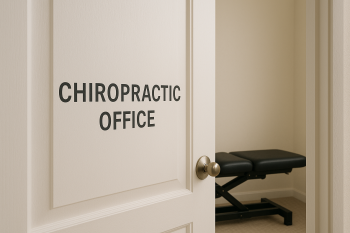
In today's world of desk jobs, smartphones, and long commutes, poor posture has become an everyday issue for many. While it might seem harmless at first, consistently maintaining a bad posture can cause chronic back pain and persistent neck pain over time. Understanding the connection between posture and pain is crucial for maintaining a healthy, pain-free life.
What Is Poor Posture?
By downloading the Digital Patient Chart mobile app you can better control your patient portal.
Posture refers to how you hold your body when standing, sitting, or lying down. Good posture means your bones, joints, and muscles are aligned properly, reducing strain and allowing for smooth, efficient movement. In contrast, poor postureplaces unnecessary stress on the spine and muscles, leading to imbalances that cause pain over time.
Common signs of poor posture include:
- Slouched shoulders
- Forward head position
- Rounded upper back
- Arched lower back
- Leaning to one side when standing or sitting
Modern habits like sitting at a computer for hours, texting on your phone, or lounging on the couch encourage these poor postural positions.
How Poor Posture Causes Chronic Back and Neck Pain
When you consistently maintain bad posture, your body adapts — but not in a good way. Over time, this misalignment leads to a variety of issues:
1. Muscle Imbalances and Strain
When certain muscles are overused to support poor posture, they become tight and overworked, while others become weak from underuse. For example, slouching forward strains the neck muscles, causing tension that often leads to neck pain. Meanwhile, the muscles in the upper back weaken, making it harder to maintain an upright position, perpetuating the cycle of poor posture.
2. Increased Pressure on the Spine
Your spine is designed to bear the body's weight when it's in proper alignment. When you slouch or hunch, you change the normal curve of your spine. This uneven pressure accelerates the wear and tear on spinal discs and joints, which can cause chronic back pain and even contribute to conditions like herniated discs and arthritis.
3. Reduced Blood Flow
Poor posture can constrict blood vessels, leading to reduced circulation, especially in the back and neck. Decreased blood flow means less oxygen and fewer nutrients are delivered to the muscles and tissues, leading to fatigue, stiffness, and pain.
4. Nerve Compression
Bad posture can compress nerves, particularly around the neck and shoulders. This compression can cause radiating pain, numbness, or tingling sensations down the arms and into the hands — symptoms often associated with conditions like thoracic outlet syndrome or cervical radiculopathy.
5. Poor Breathing Mechanics
Believe it or not, poor posture can even affect how you breathe. Slouching compresses the chest cavity, limiting lung expansion and reducing oxygen intake. Poor breathing patterns contribute to muscle tension, headaches, and fatigue, which can exacerbate feelings of pain and discomfort.
The Long-Term Effects of Ignoring Poor Posture
At first, you might only notice mild stiffness or occasional aches. However, ignoring poor posture can lead to long-term consequences, such as:
- Chronic lower back pain
- Persistent neck pain
- Spinal degeneration
- Reduced mobility and flexibility
- Increased risk of injury
Over time, even simple activities like walking, lifting groceries, or getting out of bed can become painful if posture correction is not addressed.
How to Correct Poor Posture and Prevent Pain
The good news is that it’s never too late to improve your posture and reduce your risk of chronic pain. Here are some practical tips:
1. Strengthen Postural Muscles
Incorporate exercises that target the core, back, and shoulder muscles. A strong core supports the spine and helps you maintain proper alignment naturally. Pilates, yoga, and targeted strength training can all be effective.
2. Practice Ergonomic Sitting
If you spend a lot of time at a desk, make sure your workstation is set up ergonomically. Your computer screen should be at eye level, your feet should rest flat on the floor, and your chair should support the natural curve of your lower back.
3. Take Frequent Breaks
Avoid sitting or standing in one position for too long. Set a timer to remind yourself to move every 30 minutes. Stretching, walking around, or simply changing your posture can help reduce muscle fatigue and stiffness.
4. Be Mindful of Your Movements
Whether you're texting, driving, or lifting something heavy, be aware of your body mechanics. Keep your shoulders back, engage your core, and avoid locking your knees.
5. Get Professional Help
If you’re experiencing chronic back pain or neck pain, working with a chiropractor, physical therapist, or posture specialist can be incredibly beneficial. They can assess your posture, identify problem areas, and design a personalized posture correction program.
How Chiropractic Care Can Help Improve Posture and Relieve Pain
Chiropractic care is one of the most effective ways to address poor posture and its painful consequences. Chiropractors specialize in spinal health and alignment, which makes them uniquely qualified to help patients suffering from chronic back pain and neck pain caused by postural issues.
Through a series of gentle adjustments, a chiropractor can realign the spine, reduce pressure on nerves, and restore the natural curves of the back and neck. Chiropractic adjustments not only relieve existing pain but also correct the underlying causes of poor posture, helping you maintain a healthier alignment long-term.
Poor posture may seem like a small issue, but it has a powerful cumulative effect on your health. Over time, it can lead to chronic back and neck pain, decreased mobility, and even a lower quality of life.
The key to preventing these outcomes is early intervention. By becoming more mindful of your posture, incorporating regular movement, strengthening your core muscles, and seeking professional help like chiropractic care, you can protect your spine and enjoy a healthier, more comfortable life.
If you’re already experiencing persistent discomfort, don’t wait. Seeking professional advice for posture correctioncould be the first step toward relieving your chronic pain and reclaiming your freedom of movement.
Remember: Good posture isn’t just about standing up straight — it’s about investing in your future health.









Leave a comment